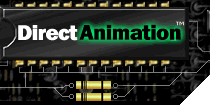



Index
Topic Contents
Previous Topic: Vectors
Next Topic: Path Control
 |
 | 
|

|
| |||
| |||
DirectAnimation Multimedia Controls
The Microsoft® DirectAnimation™ multimedia controls give you the capability to deliver impressive vector graphics, images, and animation content over the Web without incurring long download times.
- Path Control Move objects around the page over time, in geometric or spline patterns, with control over speed of motion, forward or reverse playback, looping and bouncing behavior. Sample
- Sequencer Control Create complex sequences of action involving ActiveX™ Controls, scripts, or dynamic HTML elements. Sample
- Sprite Control Add still and animated images to your Web page with control over playback speed, forward or reverse playback, dynamic seeking to different positions in the sprite playback, and user interactivity on a frame-by-frame basis. Sample
- Structured Graphics Control Add extremely lightweight vector graphics to your Web page, fully capable of being scaled or rotated in three dimensions, and then easily apply solid colors, patterns, gradient fills, or bitmap textures to these graphics. Sample
In addition to the controls, this section contains topics that discuss mouse events and a Windows metafile utility.
- Mouse Events This section describes the MouseEventsEnabled Property and mouse events that enable your control to respond to the mouse.
- Windows Metafile to Structured Graphic Converter This section describes a utility to convert Microsoft Windows® metafiles into PARAM tags.
The Path wizard sample generates basic code for moving an object around, the Rotating Text Logo wizard (Structured Graphics and Sequencer) sample generates a vector graphic text logo that rotates in three dimensions, and the Polygon Path wizard sample generates a polygon-shaped path.
Note For sound and mixing functionality, see the ActiveMovie Control in the Microsoft DirectShow™ documentation.
Documentation Conventions
Use of PARAM Tag Syntax vs. Script Syntax
Several DirectAnimation controls are documented with both PARAM tag syntax and script syntax.
PARAM tag syntax is generally used for setting parameters during object instantiation as part of an OBJECT tag. In some cases, only PARAM tag syntax can be used. In these cases, only PARAM tag syntax will be documented.
Script syntax is used in Microsoft® Visual Basic® Scripting Edition (VBScript), Microsoft JScript™, or other scripting languages to set initial values or change them during script execution. You should observe case sensitivity to ensure that scripts work as written.
The presence of both types of syntax indicate that you can set the object's parameters or call initialization methods at object instantiation on the HTML page (in the OBJECT tag), or in script. In this event, it is up to you, the author, to determine which syntax best suits your needs. For instance, you could use the PARAM tag syntax to initialize your object and then use script syntax to change it thereafter.
JScript Note When setting a series of optional parameters, JScript requires that any parameters in the middle of the series be present, not just replaced by a space. For example, if you have three optional parameters and only want to set values for parameters 1 and 3, you still need to enter a value for parameter 2 in order for parameter 3 to be read properly.
© 1998 Microsoft Corporation. All rights reserved. Terms of use.